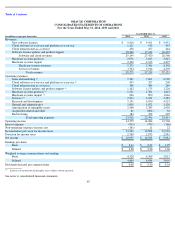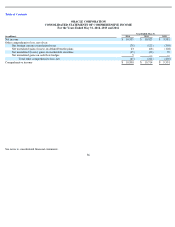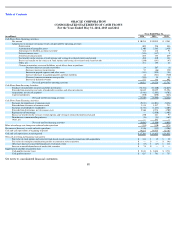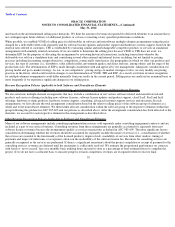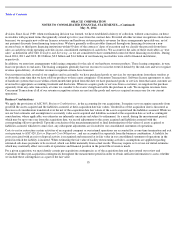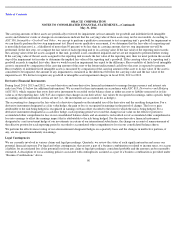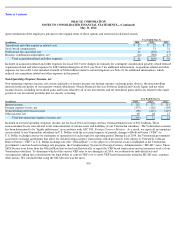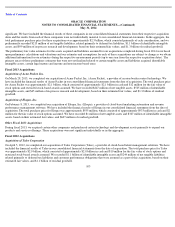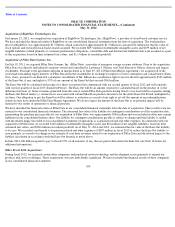Oracle 2013 Annual Report Download - page 99
Download and view the complete annual report
Please find page 99 of the 2013 Oracle annual report below. You can navigate through the pages in the report by either clicking on the pages listed below, or by using the keyword search tool below to find specific information within the annual report.
Table of Contents
ORACLE CORPORATION
NOTES TO CONSOLIDATED FINANCIAL STATEMENTS—(Continued)
May 31, 2014
division. Since fiscal 1989, when our financing division was formed, we have established a history of collection, without concessions, on these
receivables with payment terms that generally extend up to five years from the contract date. Provided all other revenue recognition criteria have
been met, we recognize new software licenses revenues and hardware systems products revenues for these arrangements upon delivery, net of
any payment discounts from financing transactions. We have generally sold receivables financed through our financing division on a non-
recourse basis to third party financing institutions within 90 days of the contracts’ dates of execution and we classify the proceeds from these
sales as cash flows from operating activities in our consolidated statements of cash flows. We account for the sales of these receivables as “true
sales” as defined in ASC 860, Transfers and Servicing , as we are considered to have surrendered control of these financing receivables. During
fiscal 2014, 2013 and 2012, $2.0 billion, $2.2 billion and $1.6 billion of our financing receivables were sold to financial institutions,
respectively.
In addition, we enter into arrangements with leasing companies for the sale of our hardware systems products. These leasing companies, in turn,
lease our products to end-users. The leasing companies generally have no recourse to us in the event of default by the end-user and we recognize
revenue upon delivery, if all other revenue recognition criteria have been met.
Our customers include several of our suppliers and occasionally, we have purchased goods or services for our operations from these vendors at
or about the same time that we have sold our products to these same companies (Concurrent Transactions). Software license agreements or sales
of hardware systems that occur within a three-
month time period from the date we have purchased goods or services from that same customer are
reviewed for appropriate accounting treatment and disclosure. When we acquire goods or services from a customer, we negotiate the purchase
separately from any sales transaction, at terms we consider to be at arm’s length and settle the purchase in cash. We recognize revenues from
Concurrent Transactions if all of our revenue recognition criteria are met and the goods and services acquired are necessary for our current
operations.
Business Combinations
We apply the provisions of ASC 805, Business Combinations , in the accounting for our acquisitions. It requires us to recognize separately from
goodwill the assets acquired and the liabilities assumed, at their acquisition date fair values. Goodwill as of the acquisition date is measured as
the excess of consideration transferred over the net of the acquisition date fair values of the assets acquired and the liabilities assumed. While we
use our best estimates and assumptions to accurately value assets acquired and liabilities assumed at the acquisition date as well as contingent
consideration, where applicable, our estimates are inherently uncertain and subject to refinement. As a result, during the measurement period,
which may be up to one year from the acquisition date, we record adjustments to the assets acquired and liabilities assumed with the
corresponding offset to goodwill. Upon the conclusion of the measurement period or final determination of the values of assets acquired or
liabilities assumed, whichever comes first, any subsequent adjustments are recorded to our consolidated statements of operations.
Costs to exit or restructure certain activities of an acquired company or our internal operations are accounted for as one-
time termination and exit
costs pursuant to ASC 420, Exit or Disposal Cost Obligations , and are accounted for separately from the business combination. A liability for
costs associated with an exit or disposal activity is recognized and measured at its fair value in our consolidated statement of operations in the
period in which the liability is incurred. When estimating the fair value of facility restructuring activities, assumptions are applied regarding
estimated sub-lease payments to be received, which can differ materially from actual results. This may require us to revise our initial estimates
which may materially affect our results of operations and financial position in the period the revision is made.
For a given acquisition, we may identify certain pre-acquisition contingencies as of the acquisition date and may extend our review and
evaluation of these pre-acquisition contingencies throughout the measurement period in order to obtain sufficient information to assess whether
we include these contingencies as a part of the fair value
95


